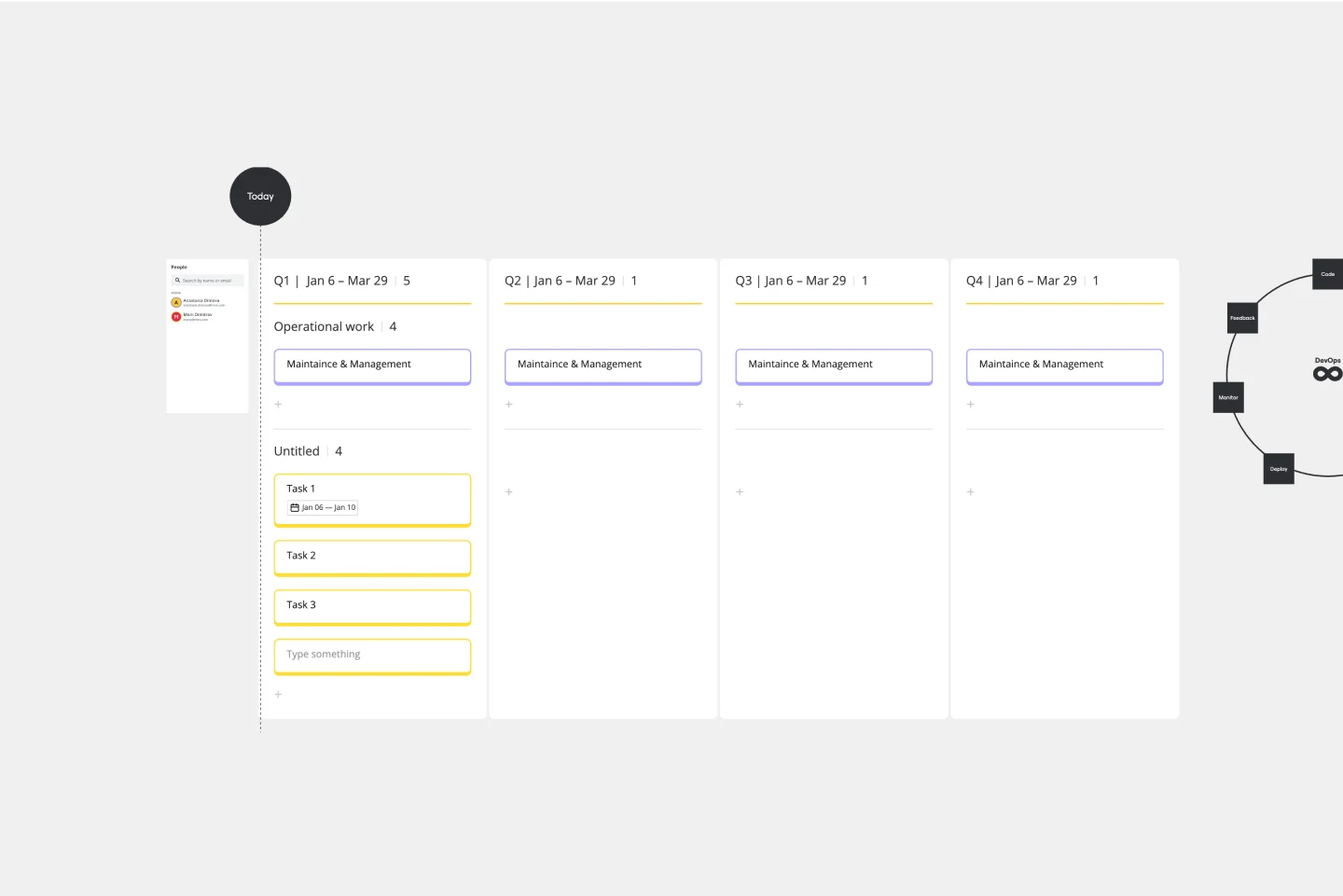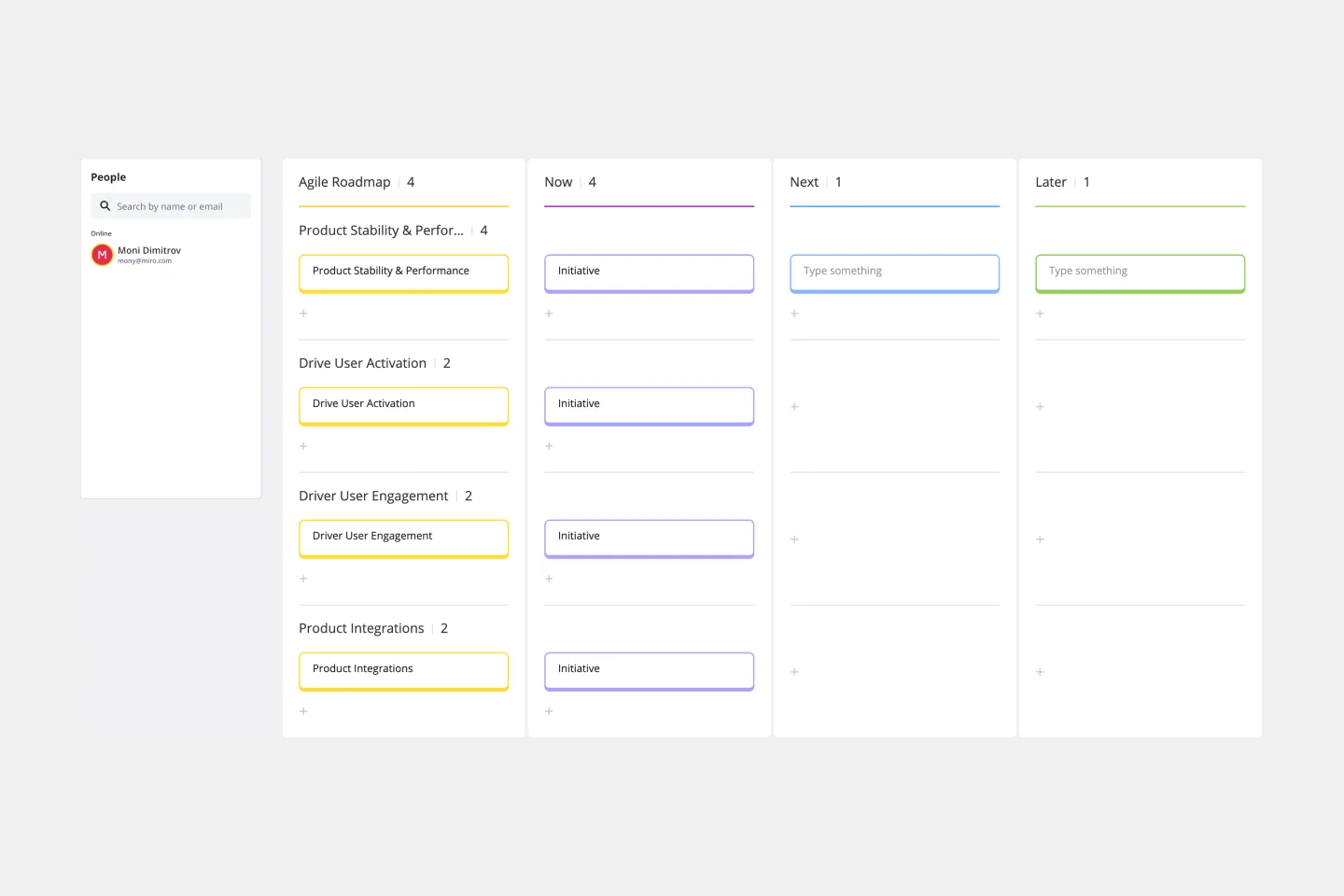About the 666 Roadmap Template
The 666 roadmap works across three timelines: one for your long-term vision, one that lets you plan (with some flexibility), and a short-term fixed plan.
This roadmap was created by Paul Adams, a VP of Product at Intercom. He believed that common suggested timelines such as two years or 18 months were either too shortsighted or too far into the future to manage unpredictability or understand the market.
Keep reading to learn more about 666 roadmaps.
What is a 666 roadmap
A 666 roadmap helps product managers plan and decide on what they’d like to build by encouraging them to focus on three key timelines:
The next six years: What will the world look like six years from now? And how will that affect today’s market trends? These questions give your team an opportunity to do some industry forecasting and future thinking, thus informing your product build.
The next six months: Think of this as a rolling timeline you can update every quarter. Over six months, you can build 50-75% of your product. That leaves 25% to chance, perhaps impacted by things you can’t predict. Progress is possible, but circumstances can change. Adapt accordingly.
The next six weeks: These are your most concrete, immediate priorities – a rolling timeline that gets updated every two weeks. Your team is usually across all the details here. They should be familiar with the design work and what’s committed to being built.
The 666 roadmap method's success hinges on product managers and their teams balancing a project’s vision and significant milestones with its day-to-day work.
When to use 666 roadmaps
These roadmaps help product managers and their teams practically plan while dealing with the realities of week-to-week workloads.
You may also need to present a 666 roadmap to your leadership or agile development team. Buy-in presentations are excellent opportunities to show everyone your confidence in balancing customer needs with your company's business objectives.
Remember that roadmaps shouldn't exist in isolation. Instead, they should back up other work your product team may be doing. You can connect roadmap goals to team progress by breaking down initiatives into epics in your product backlog. Break down these epics into requirements and user stories.
Product managers can pitch the 666 roadmap approach to their teams and any external stakeholders as an alternative to thinking in only two timelines: the twenty-year stretch and the six-month container.
Create your own 666 roadmap
Making your own 666 roadmaps is easy. Miro’s whiteboard tool is the perfect canvas to create and share them. Get started by selecting the 666 Roadmap Template, then take the following steps to make one of your own.
Record your goals for the next six years. These are your long-term product vision goals. They can be updated every two weeks to keep your goals accurate and a shared source of truth for your entire team.
Record your goals for the next six months. These are your quarterly ambitions, such as implementing a new feature. Include only as much detail as your stakeholders and team need for each column. Ideally, they should be confident in consulting the roadmap independently to understand the status of current work and long-term goals, rather than asking you for updates.
Record your goals for the next six weeks. These are your easily definable daily team goals, such quality assurance or implementing a functional customization. No more than six goals are recommended per timeline, to keep teams focused between long- and short-term ambitions.
Review and adjust the details for each timeline as needed. Make sure everyone can access the roadmap by updating your board’s Share settings as needed. Staying connected with teammates and stakeholders at all levels by automating updates (such as notifications of new changes) or regularly scheduled check-ins helps keep everyone aligned and motivated.

Miro
The AI Innovation Workspace
Miro brings teams and AI together to plan, co-create, and build the next big thing, faster. Miro empowers 100M+ users to flow from early discovery through final delivery on a shared, AI-first canvas. By embedding AI where teamwork happens, Miro breaks down silos, improves alignment, and accelerates innovation. With the canvas as the prompt, Miro’s AI capabilities keep teams in the flow of work, scale shifts in ways of working, and, ultimately, drive organization-wide transformation
Categories
Similar templates
Product Roadmap Template

Product Roadmap Template
Product roadmaps help communicate the vision and progress of what’s coming next for your product. It’s an important asset for aligning teams and valuable stakeholders – including executives, engineering, marketing, customer success, and sales – around your strategy and priorities. Product roadmapping can inform future project management, describe new features and product goals, and spell out the lifecycle of a new product. While product roadmaps are customizable, most contain information about the products you’re building, when you’re building them, and the people involved at each stage.
Go-to-Market GTM Template | Miro

Go-to-Market GTM Template | Miro
It doesn’t matter how innovative or effective a new product is — if it doesn’t get noticed and adopted by the right audience, the product won’t get off the ground. That’s where your Go-to-Market Strategy comes in. It’s a single resource that houses all of your research, insights, and data, and includes your business plan, target audience, marketing approach, and sales strategy. A GTM is especially important for any startups who grow fast, have to make split-second decisions, and have to be fully in sync.
DevOps Roadmap Template

DevOps Roadmap Template
DevOps teams are constantly creating code, iterating, and pushing it live. Against this backdrop of continuous development, it can be hard to stay abreast of your projects. Use this DevOps Roadmap template to get a granular view of the product development process and how it fits into your organization's product strategy. The DevOps Roadmap lays out the development and operations initiatives you have planned in the short term, including milestones and dependencies. This easy-to-use format is easily digestible for audiences such as product, development, and IT ops.
Agile Roadmap Template

Agile Roadmap Template
A roadmap is just as important as sprints and standups for getting Agile right. Use this template to create, revise, and communicate an Agile roadmap in collaboration with your project team.
Product Roadmap Template

Product Roadmap Template
Product roadmaps help communicate the vision and progress of what’s coming next for your product. It’s an important asset for aligning teams and valuable stakeholders – including executives, engineering, marketing, customer success, and sales – around your strategy and priorities. Product roadmapping can inform future project management, describe new features and product goals, and spell out the lifecycle of a new product. While product roadmaps are customizable, most contain information about the products you’re building, when you’re building them, and the people involved at each stage.
Go-to-Market GTM Template | Miro

Go-to-Market GTM Template | Miro
It doesn’t matter how innovative or effective a new product is — if it doesn’t get noticed and adopted by the right audience, the product won’t get off the ground. That’s where your Go-to-Market Strategy comes in. It’s a single resource that houses all of your research, insights, and data, and includes your business plan, target audience, marketing approach, and sales strategy. A GTM is especially important for any startups who grow fast, have to make split-second decisions, and have to be fully in sync.
DevOps Roadmap Template

DevOps Roadmap Template
DevOps teams are constantly creating code, iterating, and pushing it live. Against this backdrop of continuous development, it can be hard to stay abreast of your projects. Use this DevOps Roadmap template to get a granular view of the product development process and how it fits into your organization's product strategy. The DevOps Roadmap lays out the development and operations initiatives you have planned in the short term, including milestones and dependencies. This easy-to-use format is easily digestible for audiences such as product, development, and IT ops.
Agile Roadmap Template

Agile Roadmap Template
A roadmap is just as important as sprints and standups for getting Agile right. Use this template to create, revise, and communicate an Agile roadmap in collaboration with your project team.